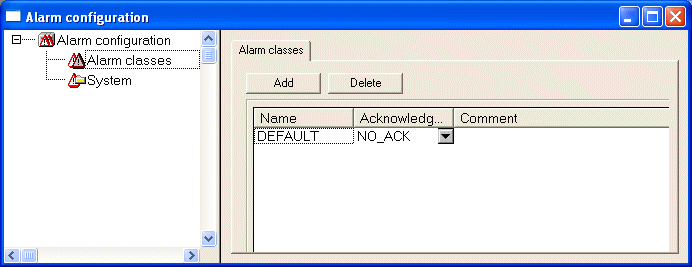Alarm Configuration
The alarm system integrated in TwinCAT PLC Control allows detecting critical process states, recording them and visualizing them for the user with the aid of a visualization element. he alarm handling can be done in TwinCAT PLC Control or alternatively in the PLC. For alarm handling in the PLC please see the target settings category 'Visualization'.
IThe dialogs for the 'Alarm configuration' are available in the 'Ressources' tab.
Here you define Alarm classes and Alarm groups. An alarm class serves for the typing of an alarm, that means it assigns certain parameters to the alarm. An alarm group serves for the concrete configuration of one or several alarms (which get assigned a certain class and further parameters) for the use in the project. Thus a class is useful for structuring the available alarms. The different alarm groups are defined by the user by inserting appropriate entries below the header 'System' in the configuration tree.
For the visualization of alarms the element 'Alarm table' is available in the visualization. Using this table the user can watch and acknowledge alarms.
If a History, i.e. recording of Alarm-Events should be written to a log-file, such a file must be defined and for each alarm group the saving behaviour must be defined.
When you open the 'Alarm configuration' in the Ressources tab, the dialog 'Alarm configuration' opens with a bi-partite window, which concerning the mode of operation is similar to that of the PLC Configuration or Task configuration.
In the left part the configuration tree is displayed, in the right part the appropriate configuration dialog will be opened.
Open by a mouse-click on the plus sign at the entry 'Alarm configuration' the currently available configuration tree. If you are going to create a new configuration, this tree only will show the entries 'Alarm classes' and 'System'.